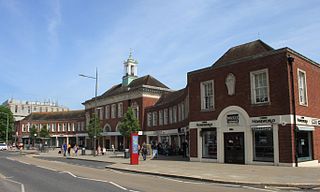
Adelaide Railway Station is the central terminus of the Adelaide Metro railway system. All lines approach the station from the west, and it is a terminal station with no through lines, with most of the traffic on the metropolitan network either departing or terminating here. It has nine platforms, all using broad gauge track. It is located on the north side of North Terrace, west of Parliament House. The Adelaide Casino occupies part of the building that is no longer required for railway use. Until 1984, Adelaide station was also the terminus for regional and interstate passenger trains, but there are no longer any regular regional train services in South Australia, and all interstate services are now handled at Adelaide Parklands Terminal.

Rail transport in Victoria, Australia, is provided by a number of railway operators who operate over the government-owned railway lines. The network consists of Victorian broad gauge lines, and an increasing number of standard gauge freight and interstate lines; the latter brought into existence as a result of gauge conversion of the former. Historically, a few experimental 762 mm gauge lines were built, along with various private logging, mining and industrial railways.
The Fremantle railway line is a suburban railway line in Western Australia that connects the state capital of Perth with the port city of Fremantle.

The first railway in colonial South Australia was a horse-drawn tramway from the port of Goolwa on the Murray River to an ocean harbour at Port Elliot in 1854. Today the state has 1,600 mm broad gauge suburban railways in Adelaide, a number of country freight lines, as well as key 1,435 mm standard gauge links to other states.

Exeter Central railway station is the most central of the stations in the city of Exeter, Devon, United Kingdom. It is 171 miles 30 chains (275.8 km) down the line from London Waterloo. The station is smaller than Exeter St David's on the west side of the city.

Salisbury Interchange is a railway station and bus interchange in the northern Adelaide suburb of Salisbury. It is on the Gawler line, 20.2 kilometres (12.6 mi) from Adelaide station. Adjoining it are a large park & ride carpark, making it one of the busiest stations on the Adelaide suburban rail system.
The Unanderra–Moss Vale railway line is a cross country railway line in New South Wales, Australia. The line branches from the Illawarra line at Unanderra and winds west up the Illawarra escarpment to join the Main South line at Moss Vale. The line is one of the most scenic in New South Wales, and for the first 20 km after leaving Unanderra has an almost continuous grade 1 in 30 providing extensive views over the Illawarra coastline.

The South Australian Railways 520 class was a class of 4-8-4 steam locomotives operated by the South Australian Railways.

The Silverton Tramway was a 58-kilometre-long 1,067 mm railway line running from Cockburn on the South Australian state border to Broken Hill in New South Wales. Operating between 1888 and 1970, it served the mines in Broken Hill, and formed the link between the 1,435 mmstandard gauge New South Wales Government Railways and the narrow gauge South Australian Railways lines. It was owned and operated by the Silverton Tramway Company (STC).

The Eyre Peninsula Railway is a 1,067 mm gauge railway on the Eyre Peninsula of South Australia. Radiating out from the ports at Port Lincoln and Thevenard, it is isolated from the rest of the South Australian railway network. Peaking at 777 kilometres in 1950, today only one 60 kilometre section remains open. It is operated by Genesee & Wyoming Australia.

The Rostock S-Bahn is a S-Bahn network in Rostock in the German state of Mecklenburg-Vorpommern. It consists of three lines with a total length of about 90 km. Line S1 runs from Rostock Hauptbahnhof to Warnemünde within the Rostock urban area. S-Bahn operations started in 1970s. Later, the lines to the north-east to the port (Seehafen) of Rostock and to the south to the town of Güstrow via Schwaan were included in the S-Bahn network. The line to the port was discontinued in 2012, but at same time the line to Güstrow via Laage was included as line S3 of the S-Bahn. Until 2014 they were mainly operated as push–pull trains with double-deck coaches. Since then all lines have been operated with new Bombardier Talent 2 railcars.
Port Pirie railway station may refer to one of the following passenger stations in Port Pirie:

The Port Pirie Post Office is a heritage-listed post office at 79-83 Ellen Street, Port Pirie, South Australia. It was designed by Edward Woods and built in 1880, with extensions designed by Charles Owen-Smyth built in 1905-1907. It was added to the South Australian Heritage Register on 12 October 1995 and added to the Commonwealth Heritage List on 8 November 2011.
The Lake Erie and Northern Railway was an interurban electric railway which consisted of a single line running north-south from Galt, Ontario to Port Dover, Ontario, running primarily through Norfolk County and Brant County, notably through the city of Brantford. It began construction in 1913 and commenced operations in 1916 as a subsidiary of the Canadian Pacific Railway (CPR), which had purchased the line before construction had finished. In 1931 it was consolidated with the Grand River Railway (GRNR) under a single CPR subsidiary, the Canadian Pacific Electric Lines (CPEL), which managed both interurban railways, though they continued to exist as legally separate entities. Passenger service was discontinued in 1955 but freight operations continued until 1961, when the LE&N electric locomotives were replaced by diesel CPR locomotives and the line was eventually de-electrified.


















